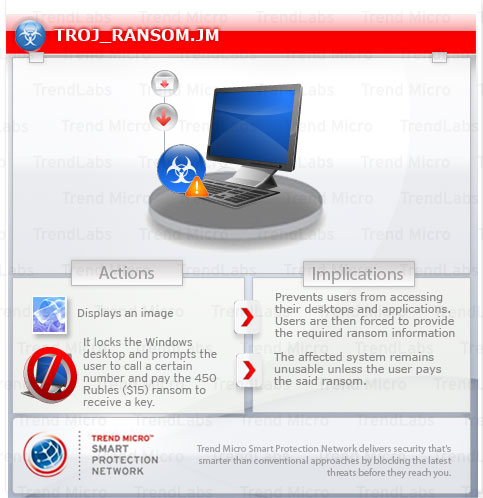TROJ_RANSOM.JM
Windows 2000, Windows XP, Windows Server 2003


Threat Type: Trojan
Destructiveness: No
Encrypted: Yes
In the wild: Yes
OVERVIEW
This ransomware Trojan uses social engineering methods to lure users into performing certain actions that may, directly or indirectly, cause malicious routines to be performed. Specifically, upon its execution, the infected system is shut down and then restart, rendering the system unusable. It prompts user to pay a certain amount to receive the key that would unlock the system.
To get a one-glance comprehensive view of the behavior of this Trojan, refer to the Threat Diagram shown below.

It locks the Windows desktop and prompts the user to call the number 9653919220 and pay the 450 Rubles ($15) ransom to receive a key. Based on its code, the key to unlock the desktop is "TNMTTF". Unless the user pays the ransom, the system remains unusable. It displays the following GUI:

This Trojan may be dropped by other malware. It may be unknowingly downloaded by a user while visiting malicious websites.
TECHNICAL DETAILS
53,760 bytes
PE
Yes
21 Jan 2011
Displays windows, Disables Windows desktop
Arrival Details
This Trojan may be dropped by other malware.
It may be unknowingly downloaded by a user while visiting malicious websites.
Installation
This Trojan drops the following files:
- %User Profile%\161933172\161933172.exe - also detected as TROJ_RANSOM.JM
(Note: %User Profile% is the current user's profile folder, which is usually C:\Documents and Settings\{user name} on Windows 2000, XP, and Server 2003, or C:\Users\{user name} on Windows Vista and 7.)
It creates the following folders:
- %User Profile%\161933172
(Note: %User Profile% is the current user's profile folder, which is usually C:\Documents and Settings\{user name} on Windows 2000, XP, and Server 2003, or C:\Users\{user name} on Windows Vista and 7.)
Autostart Technique
This Trojan adds the following registry entries to enable its automatic execution at every system startup:
HKEY_CURRENT_USER\Software\Microsoft\
Windows\CurrentVersion\Run
ZDF161933172AWrt161933172AdsWrt161933172aAdsWrtenZDF161933172_1619331720 = %User Profile%\161933172\161933172.EXE
Other Details
This Trojan does the following:
- Locks the Windows desktop and prompts the user to call a certain number and pay the 450 Rubles ($15) ransom to receive a key. Based on its code, the key to unlock the desktop is "TNMTTF". Unless the user pays the ransom, the system remains unusable. It displays the following GUI:

SOLUTION
8.900
7.784.14
21 Jan 2011
7.785.00
21 Jan 2011
Step 1
Before doing any scans, Windows XP, Windows Vista, and Windows 7 users must disable System Restore to allow full scanning of their computers.
Step 2
Restart in Safe Mode
Step 3
Delete this registry value
Important: Editing the Windows Registry incorrectly can lead to irreversible system malfunction. Please do this step only if you know how or you can ask assistance from your system administrator. Else, check this Microsoft article first before modifying your computer's registry.
- In HKEY_CURRENT_USER\Software\Microsoft\Windows\CurrentVersion\Run
- ZDF161933172AWrt161933172AdsWrt161933172aAdsWrtenZDF161933172_1619331720 = %User Profile%\161933172\161933172.EXE
Step 4
Search and delete this folder
- %User Profile%\161933172
Step 5
Restart in normal mode and scan your computer with your Trend Micro product for files detected as TROJ_RANSOM.JM. If the detected files have already been cleaned, deleted, or quarantined by your Trend Micro product, no further step is required. You may opt to simply delete the quarantined files. Please check this Knowledge Base page for more information.
Did this description help? Tell us how we did.

